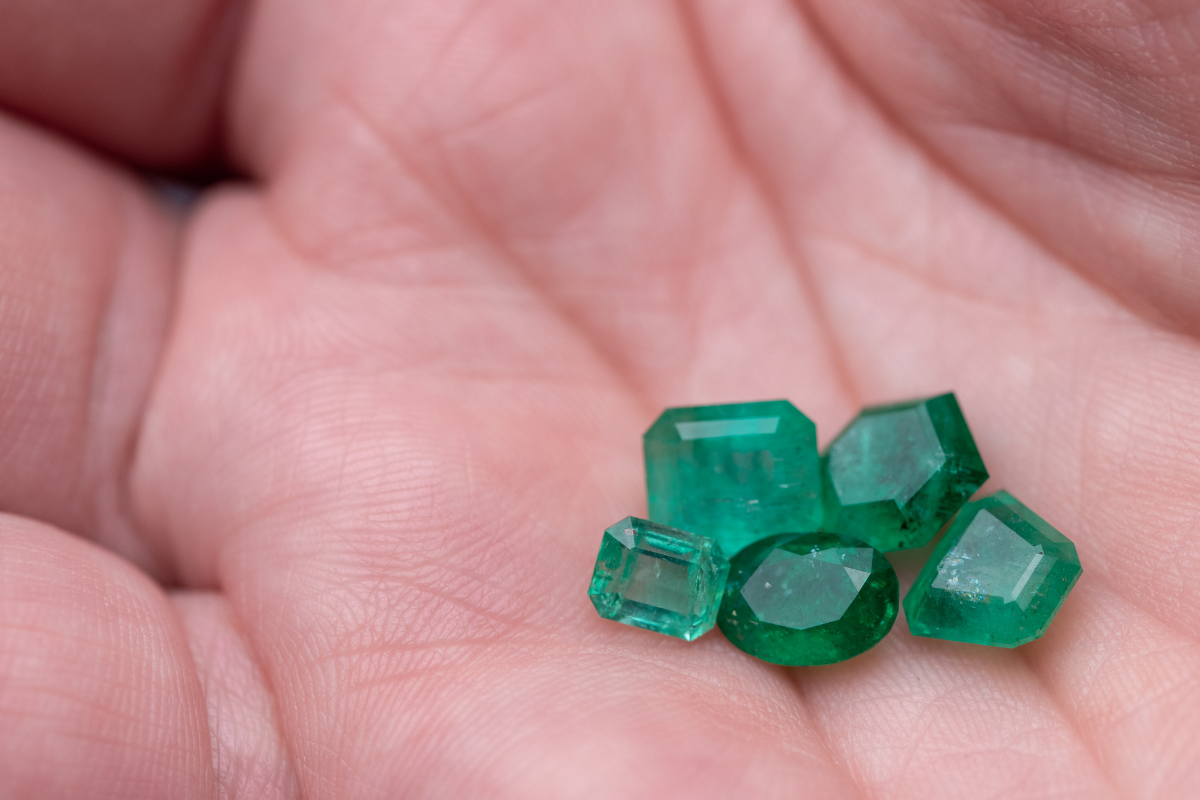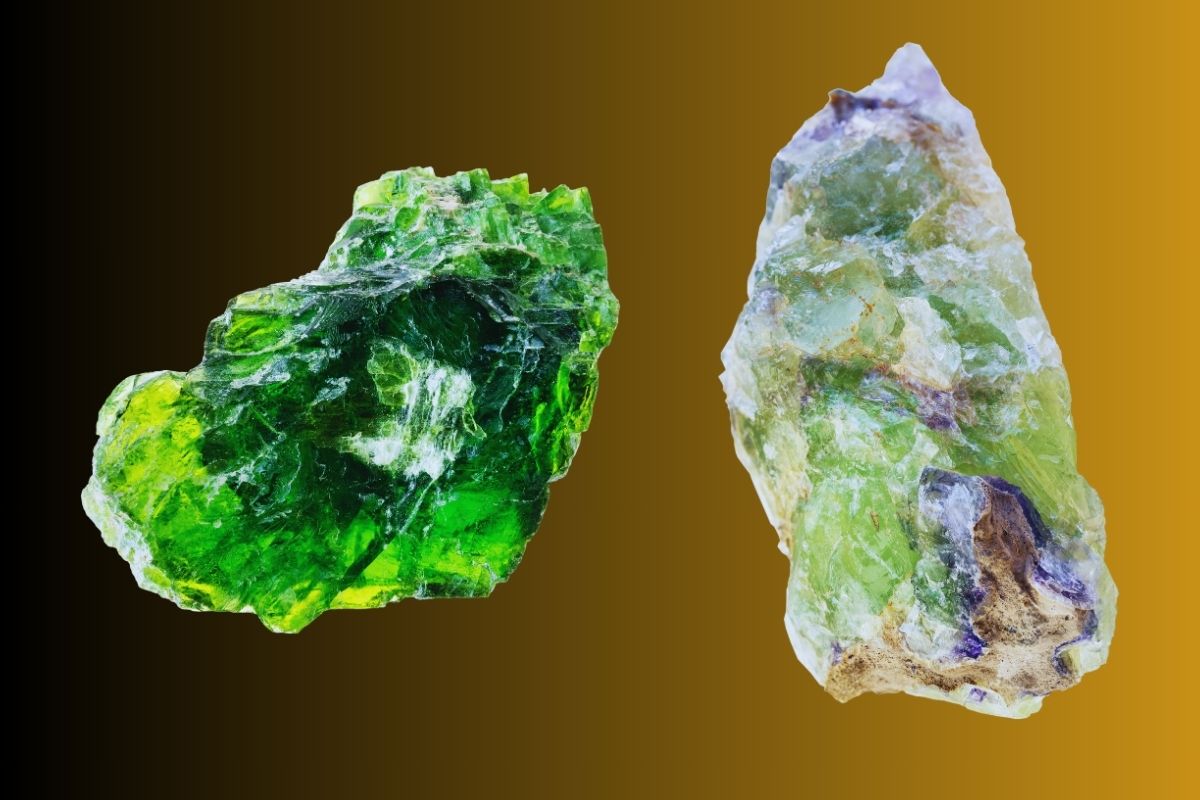
Emerald vs Green Sapphire: Comparing Durability, Price, and Color
Emeralds and green sapphires are both prestigious gems, coveted for their striking green hues, but they are distinctive in composition, appearance, and value. You may already be familiar with the rich, vibrant green of an emerald, a variety of beryl that owes its color to trace amounts of chromium and vanadium. Renowned for their place in the annals of history, emeralds have been a symbol of status and beauty since ancient civilizations.
On the other hand, green sapphires are a less common yet intriguing alternative, part of the corundum family, which includes all sapphires and rubies. Unlike emeralds, the green color in sapphires is usually due to the presence of iron and possibly vanadium, leading to a range of colors from pale to deep forest green. Though they might not carry the same traditional prestige as emeralds, green sapphires are growing in popularity owing to their unique beauty and superior durability.
Table Of Contents
- Emerald and Green Sapphire Overview
- Physical and Chemical Properties
- Aesthetic Qualities
- Valuation Factors
- Geological Formation
- Selecting Gemstones
- Care and Maintenance
- Market and Consumer Considerations
- Alternatives and Comparisons
- Ethical and Environmental Considerations
- Frequently Asked Questions
Understanding the differences between these gemstones is crucial whether you're adding to your jewelry collection or making a statement with a signature piece. Their physical properties, such as hardness, can affect their suitability for different types of jewelry. While emeralds can show a breathtaking depth of color, green sapphires offer a diverse palette and greater toughness, making them less susceptible to damage during daily wear. As you explore these gems, consider factors like color intensity, clarity, and wearability, which contribute to their symbolism and value.
Emerald and Green Sapphire Overview
As you explore the captivating world of colored gemstones, emerald and green sapphire stand out with their rich heritage and unique identities in the realm of jewelry. Grasping their history and origins will enrich your appreciation for these treasures.
History and Significance
Emerald is a gemstone that has been esteemed for millennia, with civilizations like the Egyptians mining them as early as 1500 BCE. As a birthstone for May, emeralds are celebrated for embodying the vibrant new growth of spring. They have consistently been associated with royalty and romance, being a staple in both ancient and modern crown jewels.
In contrast, green sapphire emerges from the same mineral family as sapphire, corundum, which is well-known for its blue varieties. However, green sapphires offer a more subdued and versatile color palette ranging from light mint hues to deep forest greens. Unlike emeralds, which owe their hue to chromium or vanadium, green sapphires get their color from traces of iron, making each stone's appearance uniquely linked to its origin.
Both gemstones are durable, yet emeralds often contain inclusions which are marks of their character rather than flaws. Green sapphires are typically cleaner and have a hardness that is only surpassed by diamonds, making them suitable for all types of jewelry. While emeralds have catered to a niche of exclusivity due to their rich history, green sapphires have been gaining popularity for their versatility and durability.
Physical and Chemical Properties
| Property | Emerald | Green Sapphire |
|---|---|---|
| Composition | Beryl variety containing beryllium, aluminum, silicon, and oxygen. | Corundum variety containing aluminum and oxygen with traces of iron, chromium, or vanadium. |
| Color | Typically green, ranging from light to dark shades. | Green, with variations in intensity and hue. |
| Hardness (Mohs) | 7.5 - 8 | 9 |
| Refractive Index | 1.565 - 1.602 | 1.762 - 1.778 |
| Specific Gravity | 2.72 - 2.78 | 3.95 - 4.03 |
| Cleavage | Weak | None |
| Origin | Mined in various locations, including Colombia, Zambia, and Brazil. | Found in locations such as Thailand, Australia, and Madagascar. |
When examining emeralds and green sapphires, you'll find distinct differences in their mineral composition, color nuances, and durability. Understanding these can help you appreciate the unique qualities each gemstone brings to the table.
Mineral Composition
Emeralds are a variety of the beryl mineral which includes aluminum and beryllium. They owe their green color to trace amounts of chromium and sometimes vanadium. In contrast, green sapphires are composed of corundum mineral, consisting primarily of aluminum oxide. The presence of iron and sometimes titanium determines their green shade.
Color and Hue
Emeralds are known for their vibrant green hues, but these can range from bluish-green to yellowish-green. Green sapphires come in a variety of greens, often dependent on their iron content, which can produce hues from light to dark green. Sometimes, sapphires may be artificially treated to enhance their green appearance.
Hardness and Durability
On the Mohs scale of hardness, emeralds rank at about 7.5 to 8, which makes them durable but also prone to chipping due to inclusions. Green sapphires are made of corundum, which ranks 9 on the Mohs scale, just below diamonds, making them exceptionally resilient. However, the clarity of green sapphires is usually higher due to the absence of inclusions that are commonly found in emeralds.

Aesthetic Qualities
When considering the aesthetic appeal of emeralds and green sapphires, you'll find that both stones possess unique beauty that is largely influenced by their cut and clarity. These factors contribute to the overall brilliance and appearance of the gemstones.
Cut and Shape
The cut of a gemstone greatly affects its aesthetic value. Emeralds are often found in the iconic emerald cut, a rectangular shape with stepped facets that enhance the stone's hue and limit the visibility of natural inclusions known as jardin. This cut emphasizes the deep green color and clarity, which is quintessential to the stone's beauty.
Green sapphires, on the other hand, are versatile in terms of cuts. They can be fashioned into many shapes – from traditional rounds and ovals to more intricate designs. The cut of a green sapphire aims to maximize the stone's brilliance, drawing attention to its varying shades that range from light to dark green.
Clarity and Brilliance
Clarity is crucial in determining a gemstone's quality. Emeralds often contain inclusions visible to the naked eye, which can affect clarity but are also considered by some to add character. Unlike diamonds, where clarity is often a top priority, emeralds are prized for their color foremost.
In contrast, green sapphires typically possess higher clarity, contributing to their brilliance. The fewer inclusions, the more brilliant and valuable the sapphire is considered. While emeralds might display a glassy appearance, a clear and well-cut green sapphire reflects light powerfully, making it sparkle intensely.
Valuation Factors
When you're considering the purchase of emeralds or green sapphires, understanding how they are valued is crucial. Factors like carat weight and rarity significantly influence their price tags, with direct impact on the overall cost of jewelry such as rings.
Carat Size and Weight
The carat size and weight of a gemstone are foundational to its value. For emeralds, prices escalate with size because large, high-quality specimens are rare. In contrast, green sapphire engagement rings might be more affordable; though size can also increase a green sapphire's price, they are generally less expensive than emeralds of comparable weight. Here's a simplified pricing breakdown:
-
Emeralds:
- Under 1 carat: Less expensive
- 1-5 carats: Noticeably more expensive
- Over 5 carats: Price can increase exponentially
-
Green Sapphires:
- Under 1 carat: Relatively affordable
- 1-5 carats: Moderate increase in price
- Over 5 carats: More expensive, but typically less than emeralds
Pricing and Rarity
The rarity of a gemstone is another key valuation component. Emeralds are highly prized for their rich, verdant hue and are generally more valuable. In the US, the value of an emerald can be significant, often reflecting its comparatively limited availability. Green sapphires, while rare, may not command the same price range because they are not as sought-after as their emerald counterparts. A quick look at rarity-related pricing:
- Emeralds: Rarity leads to a higher price range, especially for high-quality specimens.
- Green Sapphires: Rare but less in demand, resulting in a more affordable price tag in comparison.
Remember, while carat weight and rarity are pivotal, other factors such as clarity, color saturation, and the gemstone's origin also influence the final valuation. As you consider your options, keep these variables in mind to make an informed decision.

Geological Formation
Emerald and green sapphire, both treasured gemstones, owe their existence to distinct geological processes. While emeralds are a form of beryl, green sapphires belong to the corundum family, which also encompasses rubies. Your understanding of their origins will be deepened by examining their extraction locations.
Extraction Locations
- Emeralds: The breathtaking green hue of emeralds typically stems from chromium and vanadium presence. Their formation occurs in hydrothermal veins and metamorphic rocks. Colombia is renowned for its premium emeralds, sourced from mines in areas like Muzo and Chivor. However, quality emeralds are also mined in Zambia, where they are found in the Kagem mine, among others, and in Brazil’s Carnaiba mining district. Other noted places include Afghanistan's Panjshir Valley, showcasing the vast geographical spread of emerald formation.
- Green Sapphires: Green sapphires are less commonly known but are a remarkable part of the corundum family. They form in unique igneous and metamorphic conditions where aluminum oxide crystallizes with traces of iron and titanium, which impart the green color. Sri Lanka, known for its wide variety of sapphires, provides a source for these gemstones. The gem gravels of Ratnapura are particularly rich in corundum varieties. In Australia, sapphires are unearthed across the eastern part of the continent, with the Floodplain of New England being a significant source. American green sapphires are located in Montana, famous for the Yogo Gulch. Sapphire mining stretches to the African continent as well, with countries like Tanzania making a contribution to the global supply.
Selecting Gemstones
When choosing between emeralds and green sapphires, it is important to consider factors like hue, tone, and clarity which can influence the overall quality and appearance of the gemstone. These elements are particularly critical when selecting a stone for an engagement ring, as both the gem’s aesthetics and symbolism of loyalty, trust, and love are integral to this decision.
Identifying Quality
Quality in gemstones is determined by a combination of factors including hue, tone, color saturation, clarity, cut, and hardness. With emeralds, expect to see a warmth in hue, ranging from bluish-green to pure green. The most prized emeralds exhibit a vibrant, vivid green without being too dark. Clarity in emeralds is also important, but inclusions are more accepted than in other gemstones and can even indicate authenticity. A good cut will enhance the gemstone’s luster and overall appearance to the naked eye.
In contrast, green sapphires may have a varying tone, often lighter than that of emeralds, and can range from yellowish-green to bluish-green. Sapphires are harder than emeralds, ranked 9 on the Mohs scale, making them more resistant to scratches and suitable for daily wear rings. When evaluating green sapphires, look for a stone that offers both clarity and luster, as these are good indicators of a superior gemstone.
Comparing Emeralds and Green Sapphires
Comparing emeralds with green sapphires mainly comes down to color and durability. Emeralds are known for their unique green shade and are traditionally the choice for those seeking a gem rich in history and associated with royalty. On the other hand, green sapphires offer a more subtle yet versatile color, and their remarkable hardness makes them a durable choice for engagement rings.
Your budget can also influence your choice between these two gemstones. Generally, emeralds can be pricier, especially if the hue, tone, and clarity are aligned with top-graded stones. Green sapphires are typically more affordable and offer greater durability for the cost without compromising on the gemstone’s beauty. When contemplating your decision, remember that while emeralds command attention with their characteristic inclusions and vibrant color, green sapphires offer longevity and a unique aesthetic that may better suit an active lifestyle.

Care and Maintenance
When it comes to caring for your emerald or green sapphire, understanding their characteristics and how to handle them will ensure their longevity and sparkle. These gemstones require attention to both their physical maintenance and the environments they are exposed to.
Handling and Storage
Emeralds:
- Durability: Emeralds are less durable than sapphires, ranking 7.5-8 on the Mohs scale.
- Daily Wear: They are prone to scratches and chipping, so it's wise to remove them before engaging in physical activities.
- Treatments: Many emeralds come with oil treatments which can be affected by heat, so keep them away from high temperatures.
- Cleaning: Use a soft cloth and warm, soapy water. Avoid ultrasonic cleaners and steam.
Green Sapphires:
- Durability: Green sapphires are highly durable, ranking 9 on the Mohs scale, making them suitable for daily wear.
- Scratches/Chipping: They are resistant to scratches and chipping but should still be handled with care.
- Treatments: Some sapphires may receive heat treatments, but this generally improves toughness and color stability.
- Cleaning: Routine cleaning with a soft brush, warm water, and mild soap is safe. Ultrasonic and steam cleaners are also generally safe for sapphires.
For both gemstones, regardless of durability and treatments, always store them separately in a lined box or a soft pouch to prevent them from scratching other jewelry or being scratched themselves. Regular checks by a professional jeweler can help maintain their condition and catch any issues early.
Market and Consumer Considerations
When you explore the market for gemstone jewelry, specifically regarding emerald and green sapphire, you must consider several factors like current trends, price points, and the symbolism attached to these gemstones.
Trends in Jewelry
In the realm of jewelry, emeralds have long been cherished for their rich, verdant hue and are often associated with luxury and status due to their traditional presence in royal collections. Green sapphires, on the other hand, have seen a surge in demand as a unique and distinctive choice, especially in engagement rings, providing an alternative to more traditional stones.
From a financial perspective, your consideration should also lean towards value and investments. Emeralds can be quite expensive, but they also hold their value well, making them a worthwhile consideration for both an heirloom piece and a potential investment. Green sapphire offers a more affordable option yet still carries a high perceived value due to its durability and rarity.
The choice between these gemstones may also be influenced by the intended use, such as whether the piece is for everyday wear or special occasions. If you're looking to purchase a gift that carries a deep symbolism, you should know that emeralds are often representative of hope and renewal, while green sapphires are symbols of integrity and trustworthiness.
Understanding these points can guide you in making a decision that aligns with your personal needs and the message you wish to convey through your gemstone choice. Whether you prioritize cost, exclusivity, or meaning, your knowledge of the jewelry market's inner workings will serve as your compass.

Alternatives and Comparisons
When you're considering green gemstones, the choice often comes down to emeralds versus green sapphires. Each has unique characteristics and value factors, and knowing the differences can guide your selection effectively.
Other Gemstones
Green sapphires and emeralds are not your only options when you seek a verdant gem. Morganite and peridot offer softer greens, while garnet can exhibit a rich, grassy hue. For a more affordable choice, cubic zirconia can be produced in green to mimic the appearance of more expensive stones.
Emeralds are traditionally the May birthstone and are prized for their rich, deep green color, often with slight yellow-green to blue-green secondary hues. Their beauty comes with a caveat; emeralds usually contain inclusions, some of which are visible to the naked eye.
In contrast, green sapphires are a versatile alternative to emeralds, being very durable and available in a range of green shades, from pale to deep rich greens. They are often free of visible inclusions and can be an excellent choice for everyday wear.
While aquamarine and blue sapphire fall into different color categories, they're often considered when looking for a gemstone with cooler tones. On the warmer side, ruby and yellow-green varieties of garnet or sapphire might catch your attention.
Synthetic versions of green sapphires and emeralds are available if you're looking for an eco-friendly or budget-friendly choice. These lab-created stones replicate the appearance and physical properties of their natural counterparts without the environmental impact of mining.
Ethical and Environmental Considerations

When considering the purchase of gemstones like emeralds and sapphires, it is crucial for you to be aware of the ethical and environmental implications associated with their mining and sourcing.
Responsible Sourcing
Emeralds: High-quality emeralds are often mined in Colombia, Brazil, and Zambia. In Zambia, efforts have been made to integrate social and environmental concerns into business practices, with a focus on adding value locally. However, ethical challenges do arise from mining practices that can lead to environmental degradation and labor exploitation.
- Ethical Concerns:
- Labor conditions at mining sites
- Fair compensation for workers
- Environmental Concerns:
- Land degradation
- Water pollution
Emerald Mining in Zambia: Zambia has become a major hub for emerald mining and value addition. Regulations and practices in place are designed to mitigate negative environmental and social impacts, though enforcement and effectiveness can vary. When sourcing emeralds, consider the location and the practices of the mines to ensure they align with your ethical standards.
Sapphires: Significant sources of sapphires include countries like Madagascar, Sri Lanka, and Myanmar. Particularly in Myanmar, sapphire mining has been associated with various ethical issues, often involving labor rights concerns and environmental harm.
-
Ethical Concerns:
- Child labor risk
- Financing conflict or militarized groups
-
Environmental Concerns:
- Deforestation
- Soil erosion
Green Sapphire Value Chain: As global demand for sapphires remains high, increased scrutiny has been placed on the mining conditions and the journey of these gemstones from mine to market. It's important for you to verify the origins of green sapphires and whether the supply chain upholds environmentally friendly and ethical standards.
When choosing between emeralds and sapphires, your consideration of their sourcing is not just a reflection of your values but can also impact the future of sustainable practices in the gemstone industry.
Frequently Asked Questions
In this section, we address common inquiries regarding the comparison between emeralds and green sapphires, focusing on aspects like hardness, value, and symbolism, which are crucial when choosing a gemstone.
What are the differences in hardness between emeralds and green sapphires?
Emeralds rank at 7.5 to 8 on the Mohs scale of hardness, making them durable but prone to chipping. In contrast, green sapphires, being a variety of corundum, are much harder with a ranking of 9, thus offering superior scratch resistance.
How do the values of emeralds compare to those of green sapphires?
The value of emeralds often surpasses that of green sapphires due to their rarity and popularity. However, the highest quality green sapphires can fetch significant prices, particularly if they exhibit vivid color and clarity.
What should one consider when choosing between an emerald and a green sapphire for an engagement ring?
Consider the durability of green sapphires if your engagement ring will be worn daily. Also, factor in the emerald's unique charm and color, often associated with luxury, if aiming for a more traditional or opulent choice.
Can you distinguish a green sapphire from an emerald by appearance alone?
Yes, you can often distinguish them by appearance; emeralds usually display a brighter green with characteristic inclusions, known as jardin, while green sapphires might exhibit a more subdued, blue-green hue with fewer inclusions.
What are the symbolic meanings associated with green sapphires?
Green sapphires are believed to symbolize integrity and tranquility. They are also thought to enhance vision and foresight, making them popular choices for people seeking a stone with both beauty and meaningful symbolism.
How do the prices of green sapphires relate to the prices of other colored sapphires such as blue ones?
Green sapphires are typically less expensive than the highly sought-after blue sapphires. This is due to consumer preferences that lean towards the classic blue color. However, the unique appeal of green sapphires can command higher prices for stones with exceptional qualities.
Checkout some of our top collections:










